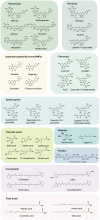Review of phytochemical and nutritional characteristics and food applications of Citrus L. fruits
- PMID: 35923210
- PMCID: PMC9339955
- DOI: 10.3389/fnut.2022.968604
Review of phytochemical and nutritional characteristics and food applications of Citrus L. fruits
Abstract
Since the dietary regimen rich in fruits is being widely recognized and encouraged, Citrus L. fruits have been growing in popularity worldwide due to their high amounts of health-promoting phytonutrients and bioactive compounds, such as flavonoids, phenolic acids, vitamins, carotenoids, pectins, and fatty acids. The diverse physicochemical properties and multiple utilization of citrus fruits in food industry are associated with their unique chemical compositions. Throughout the world, citrus has been used for producing various value-added and nutritionally enhanced products, including juices, wines, jams, canned citrus, and dried citrus. However, the current studies regarding the phytochemical and nutritional characteristics and food applications of citrus are scattered. This review systematically summarizes the existing bibliography on the chemical characteristics, functional and nutraceutical benefits, processing, and potential applications of citrus. A thorough understanding of this information may provide scientific guidance for better utilizing citrus as a functional fruit and benefit the extension of citrus value chain.
Keywords: citrus; food applications; health benefits; nutrients; phytochemicals.
Copyright © 2022 Liu, Lou, Li, Zhang, Li, Yang and Gu.
Figures
References
-
- Sharma K, Mahato N, Lee YR. Extraction, characterization and biological activity of citrus flavonoids. Rev Chem Eng. (2019) 35:265–84. 10.1515/revce-2017-0027 - DOI
-
- Porat R, Deterre S, Giampaoli P, Plotto A. The flavor of citrus fruit. In: Biotechnology in Flavor Production. Chichester, UK: John Wiley & Sons, Ltd; (2016). p. 1–31 10.1002/9781118354056.ch1 - DOI
Publication types
LinkOut - more resources
Full Text Sources





